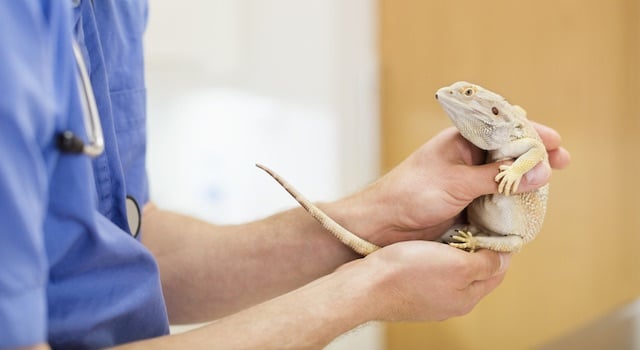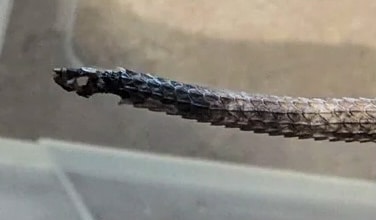
Introduction to Bearded Dragon Tail Rot
Bearded dragons are among the most popular reptiles thanks to their docile nature and ease of care. Like all pets, bearded dragons can develop certain health issues that can negatively affect their health and well-being. Bearded dragon tail rot is one of many of these health issues.
Bearded dragon tail rot is a serious health issue where tissue becomes necrotic, leading to changes in the tail’s color, texture, and smell. It’s easier to prevent than to treat, especially if it progresses to severe stages. Regularly monitoring your bearded dragon’s health and behavior for any signs of tail rot or other health conditions is crucial.
Being able to recognize the signs of tail rot can help with early detection and prompt treatment. This ensures your bearded dragon has the best chance of recovery.
What Is Bearded Dragon Tail Rot?
Definition and Explanation of Tail Rot
Tail rot is a common health condition affecting reptiles defined as necrosis of the tail tissue. It occurs when tissue becomes necrotic and dies, which can happen due to poor blood circulation, infection, or injury. The affected area decays first and will eventually progress to the rest of the tail, leaving behind a darkened area from a lack of proper blood supply. Tail rot shouldn’t be confused with stuck tail sheds or injuries, although these issues can lead to tail rot if left untreated.
Importance of Early Tail Rot Detection
Tail rot poses a serious health risk to bearded dragons and should be treated promptly. Detecting tail rot in the early stages gives your bearded dragon the best chance of recovery. If left untreated, tail rot can lead to sepsis and eventually death. Tail rot can progress to other parts of a bearded dragon’s body, like the heart and lungs. This makes it important to closely monitor your bearded dragon for signs of tail rot and other health issues as part of a daily routine health check. As soon as you suspect your bearded dragon has tail rot, you should have them checked out by a veterinarian.
Common Causes of Bearded Dragon Tail Rot
Environmental Factors
Environmental factors like poor husbandry practices or unsanitary living conditions are some of the main causes of tail rot in bearded dragons.
High levels of humidity paired with improper temperatures can lead to fungal and bacterial infections in open wounds that can trigger tail rot. Bearded dragons shouldn’t be exposed to cool, wet conditions because they are native to dry Australian deserts. They need warm temperatures and moderate humidity levels between 35-40% to stay healthy.
Various infection-causing fungi and bacteria flourish in a dirty habitat, which puts your bearded dragon at risk of developing this condition. Uneaten food and feces left to build up in the habitat create an ideal environment for these pathogens.
Physical Injury
Physical tail injuries from bites, improper handling, or falls put your bearded dragon at risk of developing tail rot. This can happen if the tail injuries become infected and cut off blood flow or are left untreated.
Bites from other bearded dragons (usually when they’re housed together) or feeder insects can become infected and lead to tail rot. Incomplete sheds can get stuck on the tail and slowly start restricting blood flow. Falls, pinches, or handling your bearded dragon roughly can cause serious tail injuries. It’s important to avoid picking your bearded dragon up by their tail or handling them far from the ground, which would make falls riskier.
Health Conditions
Certain health conditions and parasitic infections can weaken a bearded dragon’s immune system and make them more susceptible to tail rot.
Metabolic bone disease (MBD) is a common condition in reptiles that causes weakened bones and immune systems. It’s difficult for bearded dragons with MBD to fight off infections or effectively heal from injuries, putting them at risk of tail rot. However, tail rot shouldn’t be the only major concern if your bearded dragon has this condition. MBD can lead to paralysis and eventually death if left untreated.
Parasite infestations, like from mites or ticks, are stressful for bearded dragons. Their bites can leave wounds that are prone to infections. They also cause skin irritation, and bearded dragons might excessively scratch the affected areas and develop open sores on their tails. These sores are prone to infection, which can cause tail rot.
Internal parasites like pinworms can cause significant stress and weaken the immune system. Making it harder for bearded dragons to fight off infections.
Symptoms of Bearded Dragon Tail Rot
Visual Indicators
- Discoloration: Sudden darkening of the tail, either blue, brown, or black. Usually starts near the affected area and indicates tissue death.
- Dried out: A decaying tail struggles to retain moisture, making it appear abnormally dry.
- Foul odor: An unpleasant odor is associated with bacteria and fungi in the infected tissue.
- Soft, mushy texture: The tail may have a soft, mushy texture along the affected areas.

Behavioral Changes
The first sign of tail rot in bearded dragons is a sudden darkening of the tail. As the condition progresses, you may notice more severe signs like foul odor and softening of the tail. You will also notice several behavioral changes, like lethargy, loss of appetite, or pain when the tail is touched. Your bearded dragon might hide more often, refuse to eat or bask or seem irritable when handled.
Diagnosis of Bearded Dragon Tail Rot
When to Seek Veterinary Care
Tail rot doesn’t resolve on its own and needs to be treated by an exotic veterinarian who specializes in reptiles. There are no reliable home remedies to treat tail rot without seeking veterinary care.
You should seek veterinary care for your bearded dragon as soon as you notice any signs of tail rot like sudden darkening, foul odor, or recent tail injuries that may have become infected. The vet will diagnose your bearded dragon based on their symptoms and the results from diagnostic tests, like a bacterial culture to identify the bacteria causing the infection.
Differentiating from Other Conditions
Tail rot is sometimes mistaken for stuck tail shed, which can occur during the natural shedding process. While tail rot causes blackening and tissue necrosis, the stuck tail shed appears as a dull, whiteish layer of pliable skin. A stuck tail shed can lead to tail rot if blood flow is restricted, so it’s important to deal with shedding issues. If a part of your bearded dragon’s tail is turning dark, smelly, and has an abnormal texture, they are likely experiencing tail rot and not a stuck shed.
Treatment Options for Bearded Dragon Tail Rot
Initial Care
If you suspect your bearded dragon has tail rot, you should call an exotic veterinarian to have them diagnosed and treated. You should make sure your bearded dragon is comfortable while you are waiting for an appointment.
If your bearded dragons are housed together, you should isolate the affected bearded dragon. The cage mate could injure the tail further, so it’s best to separate them. Ensure that the habitat is kept clean and that your bearded dragon can easily reach their water bowl. Try to let them rest and avoid handling them to prevent further injuries and discomfort caused by moving their tail.
Veterinary Treatments
After a proper diagnosis, the veterinarian will suggest a treatment plan. Treatment will vary depending on the severity and cause of the tail rot. In mild cases, the vet may treat the underlying infection with either antibiotics, antifungals, or antiparasitic medications. In severe cases or when the initial treatment fails, the vet might suggest surgery to amputate the tail or to remove infected tissue. Pain medications may be administered to ease any discomfort or pain as your bearded dragon is recovering from tail rot.
Home Care and Recovery
You can help your bearded dragon recover from tail rot through supportive care at home. They need extra hydration, nutrition, and comfort as they heal. Make sure they eat a well-balanced diet consisting of feeder insects for protein and a selection of vegetables for fiber and essential nutrients. You should also keep the tail clean as directed by a veterinarian and apply topical antibiotics as necessary. Regular betadine soaks are often recommended to keep the tail sterile and to aid in recovery.
Closely monitor your bearded dragons tail and their behavior and take them back to the vet if they don’t seem to be getting better after treatment.
Bearded Dragon Tail Rot Prevention Strategies
Optimal Husbandry Practices
The best way to prevent tail rot is by regularly cleaning the enclosure and ensuring it is set up correctly. Bearded dragons should have a spacious, hygienic enclosure with a safe substrate and the correct heat and light setups.
They need a basking light for essential warmth and a UVB light to prevent calcium deficiencies and to keep them healthy so that they can fight off infections. To prevent wounds from developing fungal infections, keep the humidity levels between 35-40%.
Feed a nutritious omnivorous diet suitable for your bearded dragon’s life stage to prevent nutritional deficiencies that can lead to metabolic bone disease. It’s a good idea to supplement their diet with reptile multivitamins to ensure they are getting essential calcium and vitamin D3.
Proper husbandry and nutrition keeps your bearded dragon healthy and helps to prevent health conditions that could develop into tail rot.
Handling and Interaction
Handling your bearded dragon correctly helps protect them from tail injuries. You should always be as gentle as possible when interacting with them and never handle them by their tail. Make sure their entire body is supported in your hands or forearm, and keep them secure so that they can’t fall.
It’s better to only handle your bearded dragon over a soft landing like a bed, couch, or pillow in case they fall. You should never hold them far from the ground or over hard surfaces where they could fall and seriously injure themselves.
Conclusion
Tail rot is a serious health issue in bearded dragons that causes the tissue in the tail to die. This condition is primarily be caused by improper care, injuries, and infections. The main signs to look out for include discoloration of the tail, often accompanied by a foul odor and changes in texture. The infected tail may appear dry, brittle, and black as the condition worsens.
Prompt veterinary treatment can help your bearded dragon successfully recover. Treatment generally involves antibiotics or antifungal medications to treat infections and surgery to remove necrotic tissue if necessary.
You can help prevent your bearded dragon from developing tail rot with proper care and the correct handling practices.



